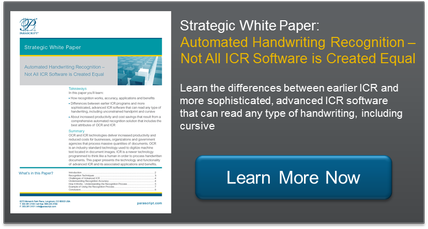A lot of folks, both technologists and end users, are very familiar with the capabilities of OCR and the technologys ability to convert images of typewritten documents into searchable electronic text. Thanks to incorporation with software packages from companies including Adobe, Apple, and Microsoft consumers and businesspeople alike can take advantage of OCRs capabilities to translate faxes, PDFs, and other images into text that can be copy-pasted or searched on their laptops. And the accuracy is very good too.
But when it comes to handwriting recognition (sometimes referred to as ICR, a topic unto itself), its an entirely different game.
With typewritten text, even though there are numerous fonts available, they are all essentially the same and they always format the letters of the alphabet in the same way. An a in Arial always looks the same. So computer software can be trained with different fonts or to ignore them entirely. But with handwriting, there can be as many variants of letters and words as there are people on earth; everyone has his or her own writing style which translates to an unknowable number of different styles of letters. So a full transcript of a handwritten letter would yield almost unusable results. Thats the bad part.
The good part is that, through context such as a supplied dictionary of words, handwriting recognition can locate and recognize specific words regardless of handwriting style and use that to support business processes. Take for instance the need to process customer service correspondence. Most businesses have a good understanding of concepts that can be used to classify correspondence. Working in the same manner as a person quickly skimming a letter to find key words or phrases, handwriting recognition software can do the same thing and then apply rules to classify and route the document to the correct process. The same can be accomplished for documents like patient charts using medical codes and diagnostic dictionaries.
In future posts, well cover more detail on how handwriting recognition uses context to make this all work, and make it work well.

